Analyzing the E-Mental Health Strategy and Reforms in Australia
VerifiedAdded on 2023/06/03
|12
|3079
|396
Report
AI Summary
This report provides an overview of the E-mental health strategies implemented by the Australian government to deliver online mental health services through websites and apps. It highlights the usefulness of this approach for individuals with mild to moderate cognitive disorders who can benefit from online counseling. The report also addresses potential limitations, such as privacy breaches, high costs, and legal challenges related to geographical constraints. Based on these limitations, the report recommends increased government funding, effective information dissemination, and robust cybersecurity measures to protect patient data. The discussion encompasses the benefits of e-mental health services, including accessibility and social support, while also acknowledging concerns about cost-effectiveness, privacy, and the suitability of online therapy for severe psychiatric conditions. The report concludes by emphasizing the need for ongoing efforts to improve the effectiveness and accessibility of e-mental health reforms in Australia.
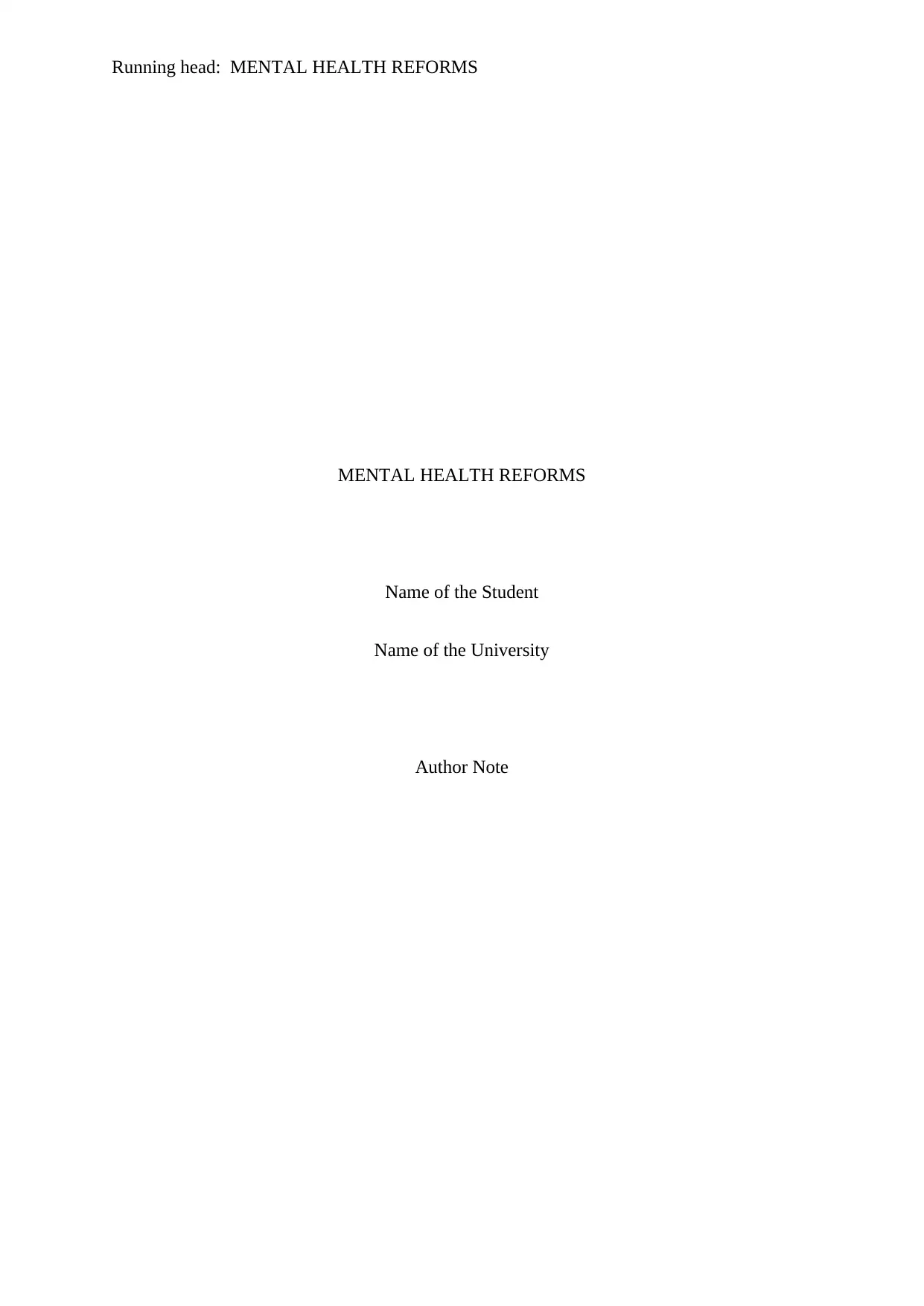
Running head: MENTAL HEALTH REFORMS
MENTAL HEALTH REFORMS
Name of the Student
Name of the University
Author Note
MENTAL HEALTH REFORMS
Name of the Student
Name of the University
Author Note
Paraphrase This Document
Need a fresh take? Get an instant paraphrase of this document with our AI Paraphraser
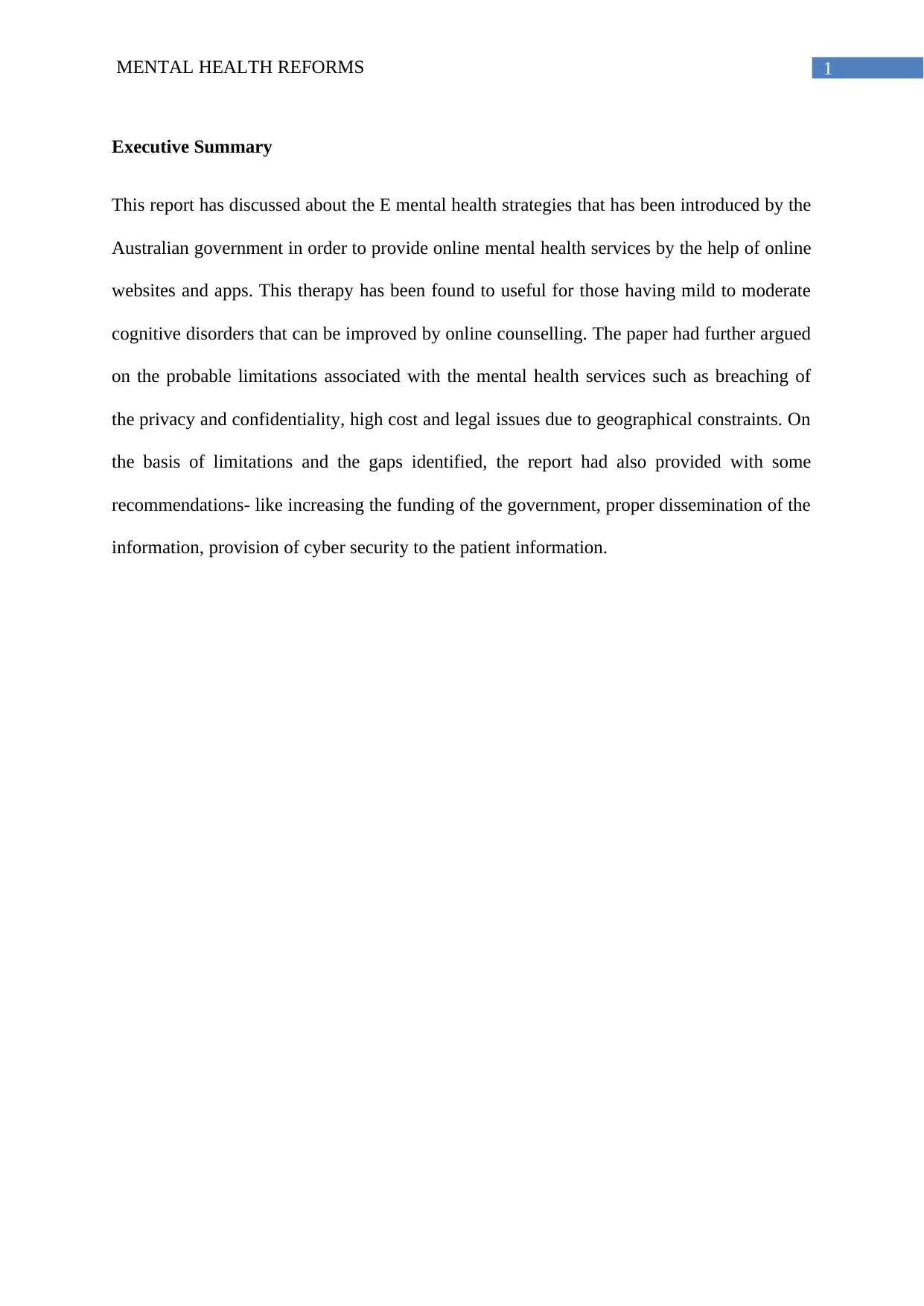
1MENTAL HEALTH REFORMS
Executive Summary
This report has discussed about the E mental health strategies that has been introduced by the
Australian government in order to provide online mental health services by the help of online
websites and apps. This therapy has been found to useful for those having mild to moderate
cognitive disorders that can be improved by online counselling. The paper had further argued
on the probable limitations associated with the mental health services such as breaching of
the privacy and confidentiality, high cost and legal issues due to geographical constraints. On
the basis of limitations and the gaps identified, the report had also provided with some
recommendations- like increasing the funding of the government, proper dissemination of the
information, provision of cyber security to the patient information.
Executive Summary
This report has discussed about the E mental health strategies that has been introduced by the
Australian government in order to provide online mental health services by the help of online
websites and apps. This therapy has been found to useful for those having mild to moderate
cognitive disorders that can be improved by online counselling. The paper had further argued
on the probable limitations associated with the mental health services such as breaching of
the privacy and confidentiality, high cost and legal issues due to geographical constraints. On
the basis of limitations and the gaps identified, the report had also provided with some
recommendations- like increasing the funding of the government, proper dissemination of the
information, provision of cyber security to the patient information.
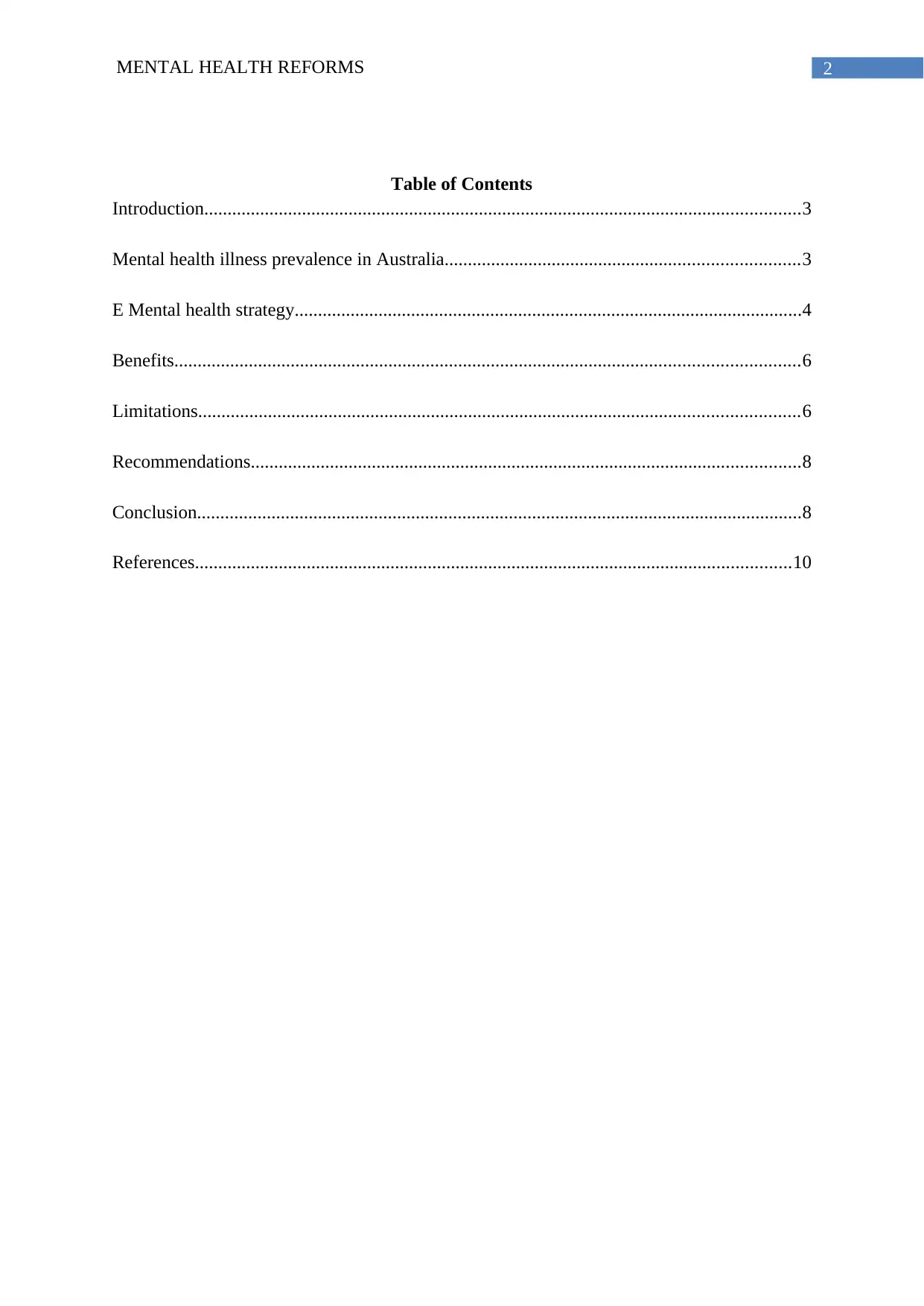
2MENTAL HEALTH REFORMS
Table of Contents
Introduction................................................................................................................................3
Mental health illness prevalence in Australia............................................................................3
E Mental health strategy.............................................................................................................4
Benefits......................................................................................................................................6
Limitations.................................................................................................................................6
Recommendations......................................................................................................................8
Conclusion..................................................................................................................................8
References................................................................................................................................10
Table of Contents
Introduction................................................................................................................................3
Mental health illness prevalence in Australia............................................................................3
E Mental health strategy.............................................................................................................4
Benefits......................................................................................................................................6
Limitations.................................................................................................................................6
Recommendations......................................................................................................................8
Conclusion..................................................................................................................................8
References................................................................................................................................10
⊘ This is a preview!⊘
Do you want full access?
Subscribe today to unlock all pages.

Trusted by 1+ million students worldwide
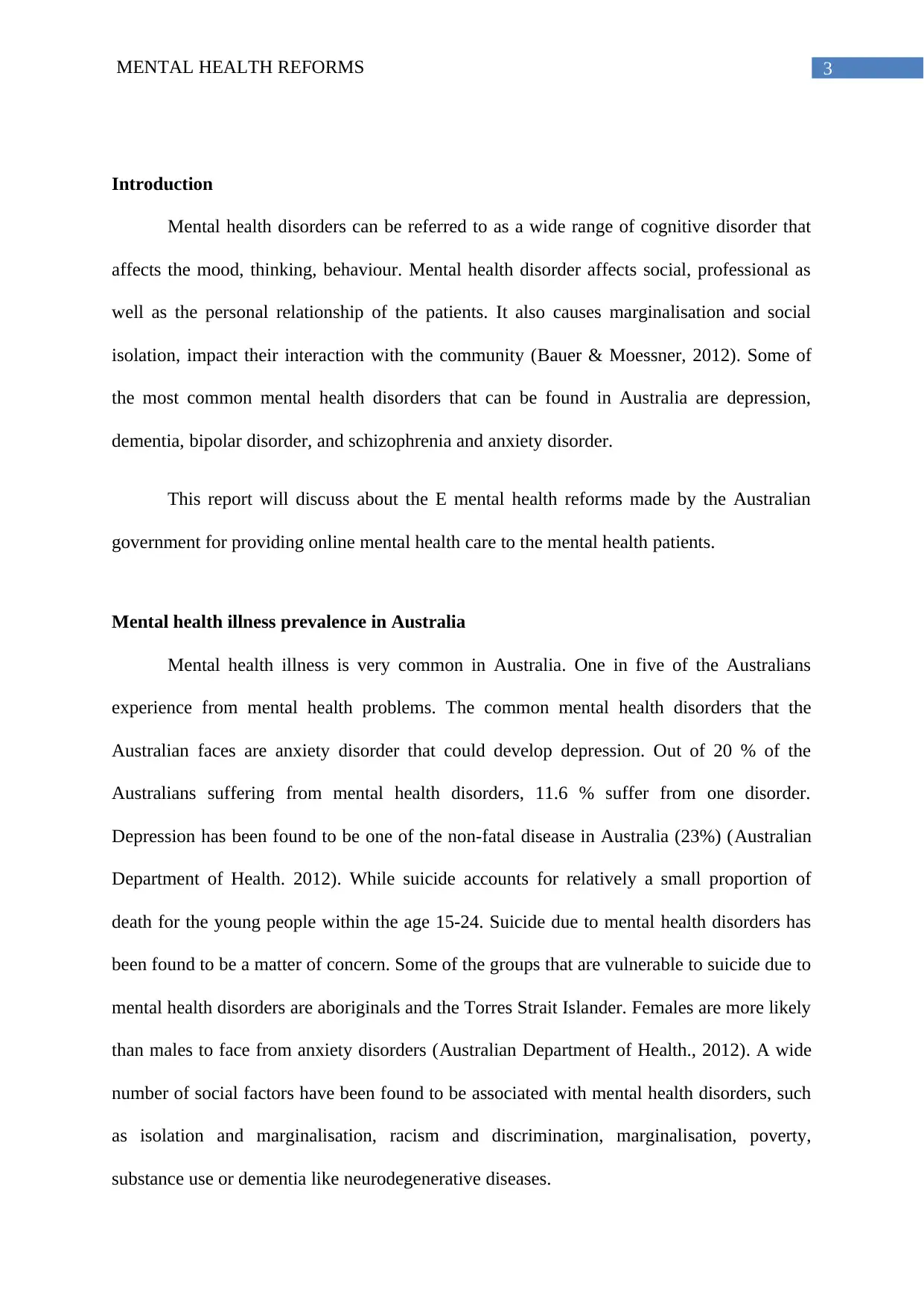
3MENTAL HEALTH REFORMS
Introduction
Mental health disorders can be referred to as a wide range of cognitive disorder that
affects the mood, thinking, behaviour. Mental health disorder affects social, professional as
well as the personal relationship of the patients. It also causes marginalisation and social
isolation, impact their interaction with the community (Bauer & Moessner, 2012). Some of
the most common mental health disorders that can be found in Australia are depression,
dementia, bipolar disorder, and schizophrenia and anxiety disorder.
This report will discuss about the E mental health reforms made by the Australian
government for providing online mental health care to the mental health patients.
Mental health illness prevalence in Australia
Mental health illness is very common in Australia. One in five of the Australians
experience from mental health problems. The common mental health disorders that the
Australian faces are anxiety disorder that could develop depression. Out of 20 % of the
Australians suffering from mental health disorders, 11.6 % suffer from one disorder.
Depression has been found to be one of the non-fatal disease in Australia (23%) (Australian
Department of Health. 2012). While suicide accounts for relatively a small proportion of
death for the young people within the age 15-24. Suicide due to mental health disorders has
been found to be a matter of concern. Some of the groups that are vulnerable to suicide due to
mental health disorders are aboriginals and the Torres Strait Islander. Females are more likely
than males to face from anxiety disorders (Australian Department of Health., 2012). A wide
number of social factors have been found to be associated with mental health disorders, such
as isolation and marginalisation, racism and discrimination, marginalisation, poverty,
substance use or dementia like neurodegenerative diseases.
Introduction
Mental health disorders can be referred to as a wide range of cognitive disorder that
affects the mood, thinking, behaviour. Mental health disorder affects social, professional as
well as the personal relationship of the patients. It also causes marginalisation and social
isolation, impact their interaction with the community (Bauer & Moessner, 2012). Some of
the most common mental health disorders that can be found in Australia are depression,
dementia, bipolar disorder, and schizophrenia and anxiety disorder.
This report will discuss about the E mental health reforms made by the Australian
government for providing online mental health care to the mental health patients.
Mental health illness prevalence in Australia
Mental health illness is very common in Australia. One in five of the Australians
experience from mental health problems. The common mental health disorders that the
Australian faces are anxiety disorder that could develop depression. Out of 20 % of the
Australians suffering from mental health disorders, 11.6 % suffer from one disorder.
Depression has been found to be one of the non-fatal disease in Australia (23%) (Australian
Department of Health. 2012). While suicide accounts for relatively a small proportion of
death for the young people within the age 15-24. Suicide due to mental health disorders has
been found to be a matter of concern. Some of the groups that are vulnerable to suicide due to
mental health disorders are aboriginals and the Torres Strait Islander. Females are more likely
than males to face from anxiety disorders (Australian Department of Health., 2012). A wide
number of social factors have been found to be associated with mental health disorders, such
as isolation and marginalisation, racism and discrimination, marginalisation, poverty,
substance use or dementia like neurodegenerative diseases.
Paraphrase This Document
Need a fresh take? Get an instant paraphrase of this document with our AI Paraphraser
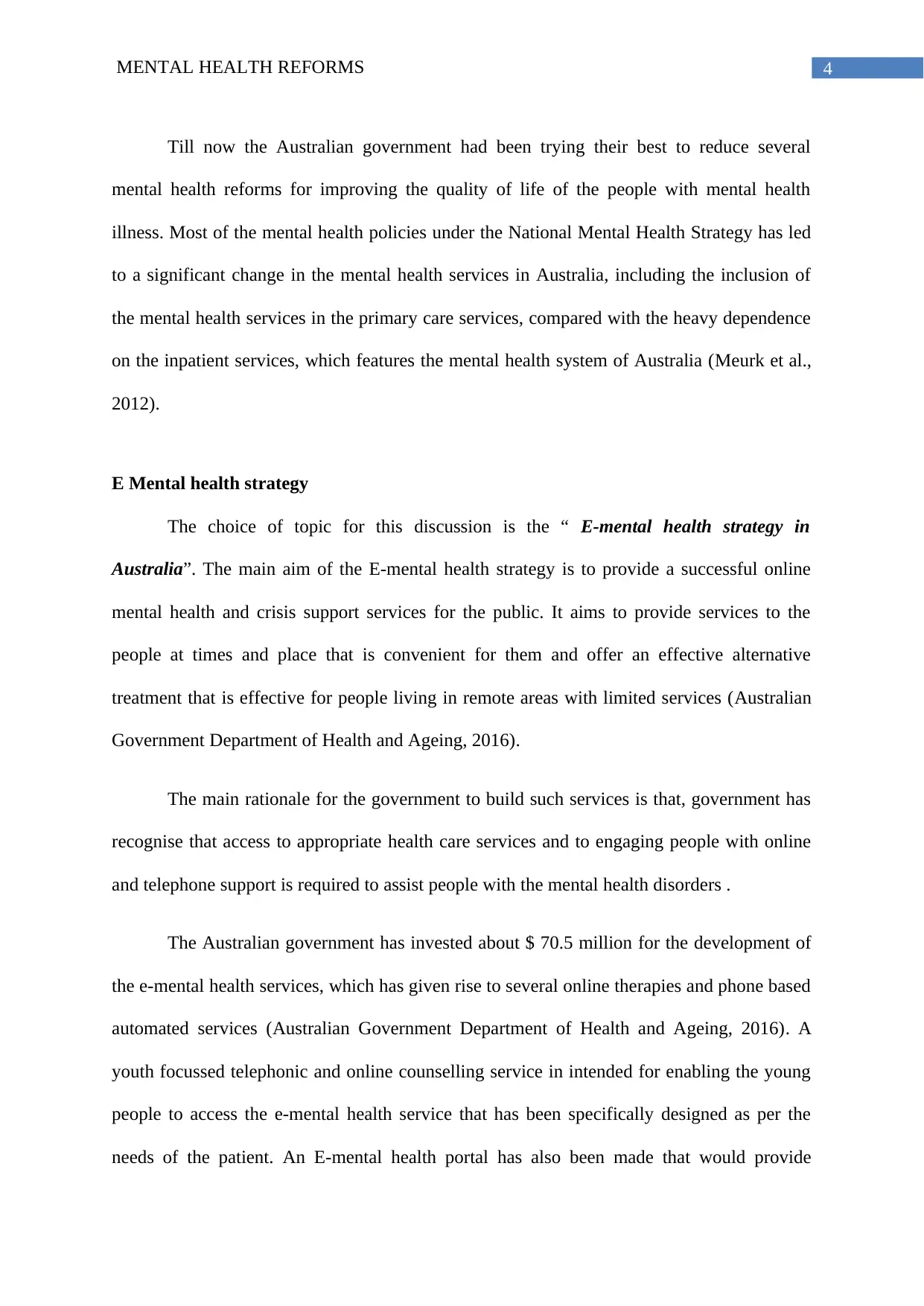
4MENTAL HEALTH REFORMS
Till now the Australian government had been trying their best to reduce several
mental health reforms for improving the quality of life of the people with mental health
illness. Most of the mental health policies under the National Mental Health Strategy has led
to a significant change in the mental health services in Australia, including the inclusion of
the mental health services in the primary care services, compared with the heavy dependence
on the inpatient services, which features the mental health system of Australia (Meurk et al.,
2012).
E Mental health strategy
The choice of topic for this discussion is the “ E-mental health strategy in
Australia”. The main aim of the E-mental health strategy is to provide a successful online
mental health and crisis support services for the public. It aims to provide services to the
people at times and place that is convenient for them and offer an effective alternative
treatment that is effective for people living in remote areas with limited services (Australian
Government Department of Health and Ageing, 2016).
The main rationale for the government to build such services is that, government has
recognise that access to appropriate health care services and to engaging people with online
and telephone support is required to assist people with the mental health disorders .
The Australian government has invested about $ 70.5 million for the development of
the e-mental health services, which has given rise to several online therapies and phone based
automated services (Australian Government Department of Health and Ageing, 2016). A
youth focussed telephonic and online counselling service in intended for enabling the young
people to access the e-mental health service that has been specifically designed as per the
needs of the patient. An E-mental health portal has also been made that would provide
Till now the Australian government had been trying their best to reduce several
mental health reforms for improving the quality of life of the people with mental health
illness. Most of the mental health policies under the National Mental Health Strategy has led
to a significant change in the mental health services in Australia, including the inclusion of
the mental health services in the primary care services, compared with the heavy dependence
on the inpatient services, which features the mental health system of Australia (Meurk et al.,
2012).
E Mental health strategy
The choice of topic for this discussion is the “ E-mental health strategy in
Australia”. The main aim of the E-mental health strategy is to provide a successful online
mental health and crisis support services for the public. It aims to provide services to the
people at times and place that is convenient for them and offer an effective alternative
treatment that is effective for people living in remote areas with limited services (Australian
Government Department of Health and Ageing, 2016).
The main rationale for the government to build such services is that, government has
recognise that access to appropriate health care services and to engaging people with online
and telephone support is required to assist people with the mental health disorders .
The Australian government has invested about $ 70.5 million for the development of
the e-mental health services, which has given rise to several online therapies and phone based
automated services (Australian Government Department of Health and Ageing, 2016). A
youth focussed telephonic and online counselling service in intended for enabling the young
people to access the e-mental health service that has been specifically designed as per the
needs of the patient. An E-mental health portal has also been made that would provide
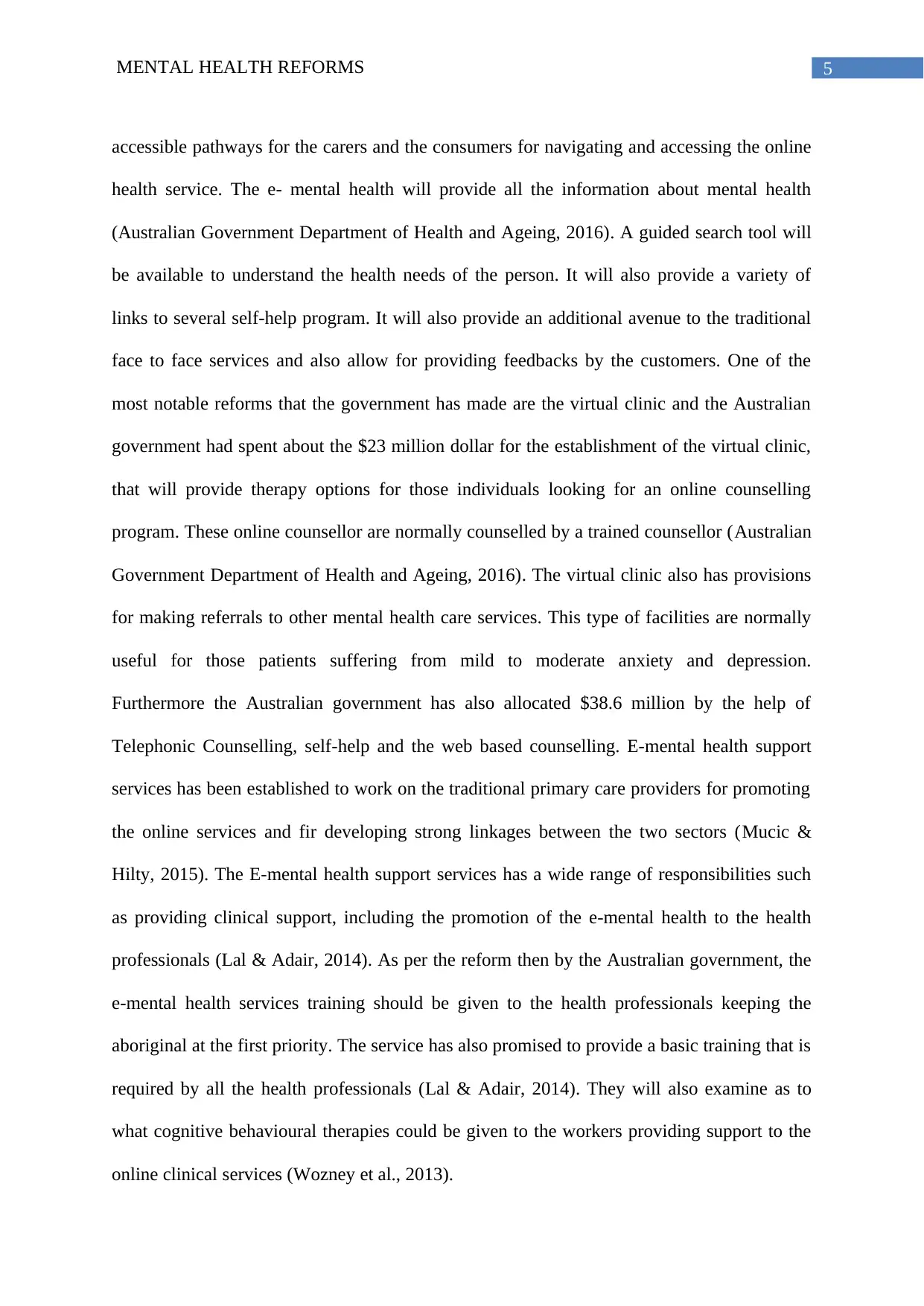
5MENTAL HEALTH REFORMS
accessible pathways for the carers and the consumers for navigating and accessing the online
health service. The e- mental health will provide all the information about mental health
(Australian Government Department of Health and Ageing, 2016). A guided search tool will
be available to understand the health needs of the person. It will also provide a variety of
links to several self-help program. It will also provide an additional avenue to the traditional
face to face services and also allow for providing feedbacks by the customers. One of the
most notable reforms that the government has made are the virtual clinic and the Australian
government had spent about the $23 million dollar for the establishment of the virtual clinic,
that will provide therapy options for those individuals looking for an online counselling
program. These online counsellor are normally counselled by a trained counsellor (Australian
Government Department of Health and Ageing, 2016). The virtual clinic also has provisions
for making referrals to other mental health care services. This type of facilities are normally
useful for those patients suffering from mild to moderate anxiety and depression.
Furthermore the Australian government has also allocated $38.6 million by the help of
Telephonic Counselling, self-help and the web based counselling. E-mental health support
services has been established to work on the traditional primary care providers for promoting
the online services and fir developing strong linkages between the two sectors (Mucic &
Hilty, 2015). The E-mental health support services has a wide range of responsibilities such
as providing clinical support, including the promotion of the e-mental health to the health
professionals (Lal & Adair, 2014). As per the reform then by the Australian government, the
e-mental health services training should be given to the health professionals keeping the
aboriginal at the first priority. The service has also promised to provide a basic training that is
required by all the health professionals (Lal & Adair, 2014). They will also examine as to
what cognitive behavioural therapies could be given to the workers providing support to the
online clinical services (Wozney et al., 2013).
accessible pathways for the carers and the consumers for navigating and accessing the online
health service. The e- mental health will provide all the information about mental health
(Australian Government Department of Health and Ageing, 2016). A guided search tool will
be available to understand the health needs of the person. It will also provide a variety of
links to several self-help program. It will also provide an additional avenue to the traditional
face to face services and also allow for providing feedbacks by the customers. One of the
most notable reforms that the government has made are the virtual clinic and the Australian
government had spent about the $23 million dollar for the establishment of the virtual clinic,
that will provide therapy options for those individuals looking for an online counselling
program. These online counsellor are normally counselled by a trained counsellor (Australian
Government Department of Health and Ageing, 2016). The virtual clinic also has provisions
for making referrals to other mental health care services. This type of facilities are normally
useful for those patients suffering from mild to moderate anxiety and depression.
Furthermore the Australian government has also allocated $38.6 million by the help of
Telephonic Counselling, self-help and the web based counselling. E-mental health support
services has been established to work on the traditional primary care providers for promoting
the online services and fir developing strong linkages between the two sectors (Mucic &
Hilty, 2015). The E-mental health support services has a wide range of responsibilities such
as providing clinical support, including the promotion of the e-mental health to the health
professionals (Lal & Adair, 2014). As per the reform then by the Australian government, the
e-mental health services training should be given to the health professionals keeping the
aboriginal at the first priority. The service has also promised to provide a basic training that is
required by all the health professionals (Lal & Adair, 2014). They will also examine as to
what cognitive behavioural therapies could be given to the workers providing support to the
online clinical services (Wozney et al., 2013).
⊘ This is a preview!⊘
Do you want full access?
Subscribe today to unlock all pages.

Trusted by 1+ million students worldwide
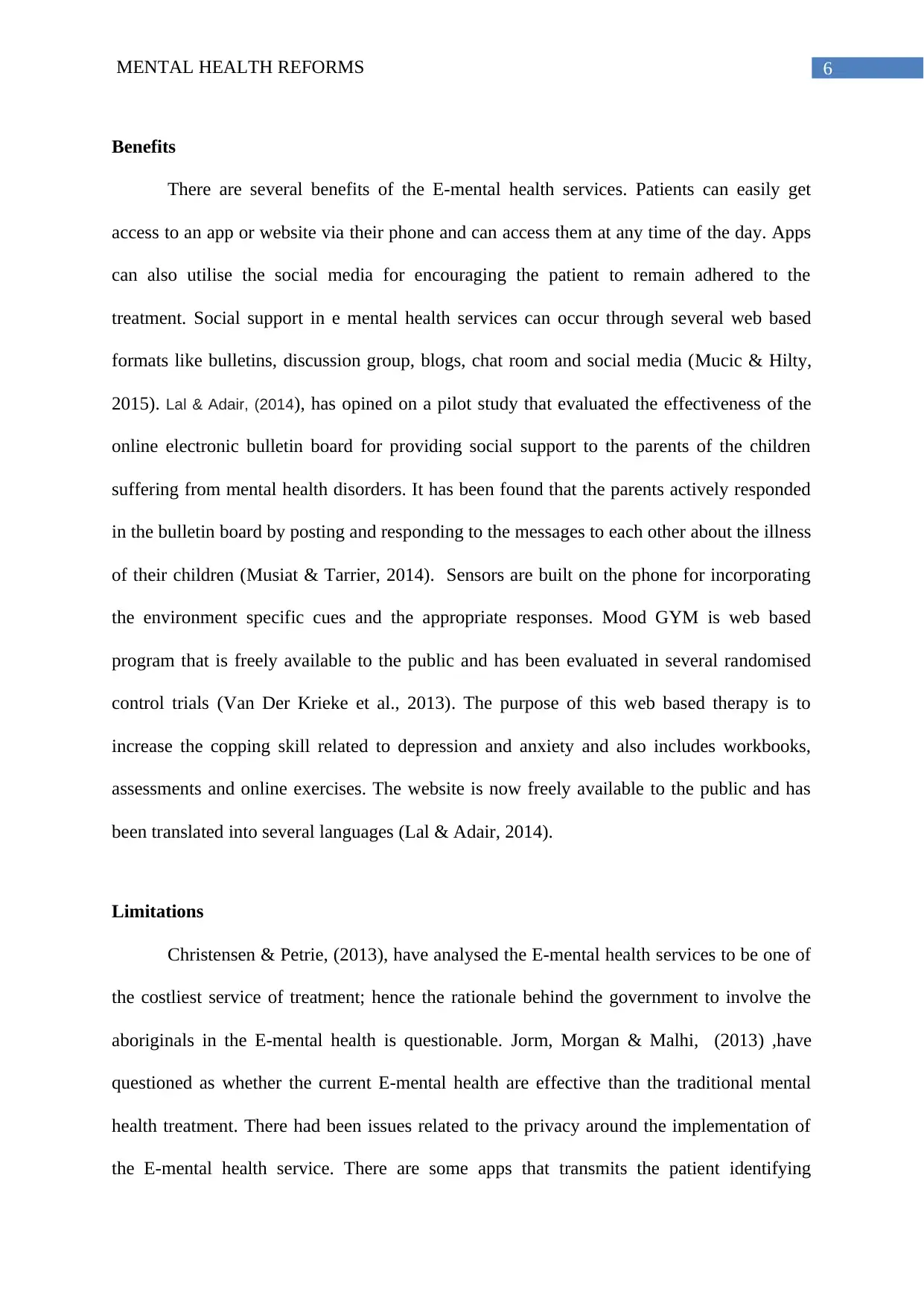
6MENTAL HEALTH REFORMS
Benefits
There are several benefits of the E-mental health services. Patients can easily get
access to an app or website via their phone and can access them at any time of the day. Apps
can also utilise the social media for encouraging the patient to remain adhered to the
treatment. Social support in e mental health services can occur through several web based
formats like bulletins, discussion group, blogs, chat room and social media (Mucic & Hilty,
2015). Lal & Adair, (2014), has opined on a pilot study that evaluated the effectiveness of the
online electronic bulletin board for providing social support to the parents of the children
suffering from mental health disorders. It has been found that the parents actively responded
in the bulletin board by posting and responding to the messages to each other about the illness
of their children (Musiat & Tarrier, 2014). Sensors are built on the phone for incorporating
the environment specific cues and the appropriate responses. Mood GYM is web based
program that is freely available to the public and has been evaluated in several randomised
control trials (Van Der Krieke et al., 2013). The purpose of this web based therapy is to
increase the copping skill related to depression and anxiety and also includes workbooks,
assessments and online exercises. The website is now freely available to the public and has
been translated into several languages (Lal & Adair, 2014).
Limitations
Christensen & Petrie, (2013), have analysed the E-mental health services to be one of
the costliest service of treatment; hence the rationale behind the government to involve the
aboriginals in the E-mental health is questionable. Jorm, Morgan & Malhi, (2013) ,have
questioned as whether the current E-mental health are effective than the traditional mental
health treatment. There had been issues related to the privacy around the implementation of
the E-mental health service. There are some apps that transmits the patient identifying
Benefits
There are several benefits of the E-mental health services. Patients can easily get
access to an app or website via their phone and can access them at any time of the day. Apps
can also utilise the social media for encouraging the patient to remain adhered to the
treatment. Social support in e mental health services can occur through several web based
formats like bulletins, discussion group, blogs, chat room and social media (Mucic & Hilty,
2015). Lal & Adair, (2014), has opined on a pilot study that evaluated the effectiveness of the
online electronic bulletin board for providing social support to the parents of the children
suffering from mental health disorders. It has been found that the parents actively responded
in the bulletin board by posting and responding to the messages to each other about the illness
of their children (Musiat & Tarrier, 2014). Sensors are built on the phone for incorporating
the environment specific cues and the appropriate responses. Mood GYM is web based
program that is freely available to the public and has been evaluated in several randomised
control trials (Van Der Krieke et al., 2013). The purpose of this web based therapy is to
increase the copping skill related to depression and anxiety and also includes workbooks,
assessments and online exercises. The website is now freely available to the public and has
been translated into several languages (Lal & Adair, 2014).
Limitations
Christensen & Petrie, (2013), have analysed the E-mental health services to be one of
the costliest service of treatment; hence the rationale behind the government to involve the
aboriginals in the E-mental health is questionable. Jorm, Morgan & Malhi, (2013) ,have
questioned as whether the current E-mental health are effective than the traditional mental
health treatment. There had been issues related to the privacy around the implementation of
the E-mental health service. There are some apps that transmits the patient identifying
Paraphrase This Document
Need a fresh take? Get an instant paraphrase of this document with our AI Paraphraser
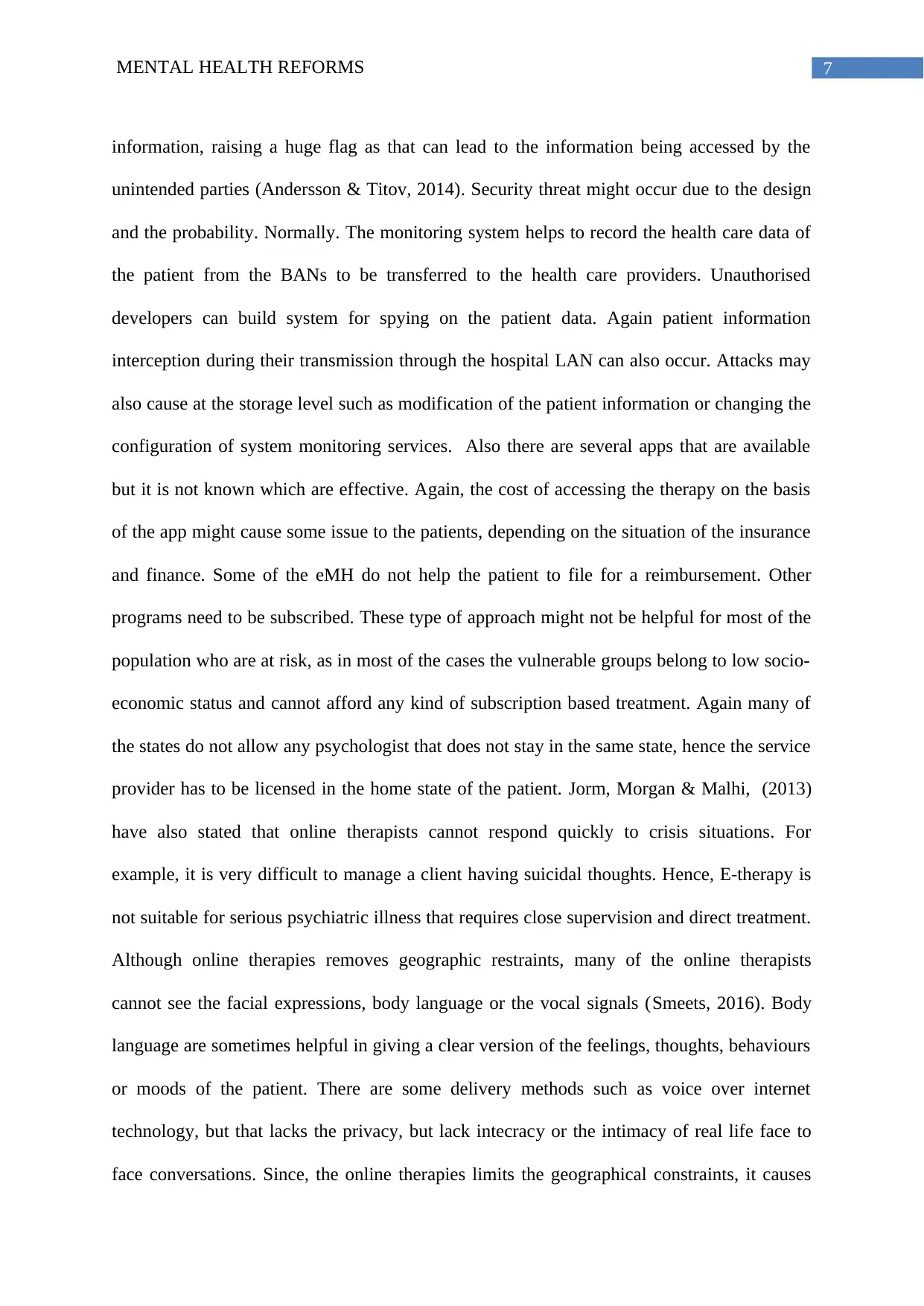
7MENTAL HEALTH REFORMS
information, raising a huge flag as that can lead to the information being accessed by the
unintended parties (Andersson & Titov, 2014). Security threat might occur due to the design
and the probability. Normally. The monitoring system helps to record the health care data of
the patient from the BANs to be transferred to the health care providers. Unauthorised
developers can build system for spying on the patient data. Again patient information
interception during their transmission through the hospital LAN can also occur. Attacks may
also cause at the storage level such as modification of the patient information or changing the
configuration of system monitoring services. Also there are several apps that are available
but it is not known which are effective. Again, the cost of accessing the therapy on the basis
of the app might cause some issue to the patients, depending on the situation of the insurance
and finance. Some of the eMH do not help the patient to file for a reimbursement. Other
programs need to be subscribed. These type of approach might not be helpful for most of the
population who are at risk, as in most of the cases the vulnerable groups belong to low socio-
economic status and cannot afford any kind of subscription based treatment. Again many of
the states do not allow any psychologist that does not stay in the same state, hence the service
provider has to be licensed in the home state of the patient. Jorm, Morgan & Malhi, (2013)
have also stated that online therapists cannot respond quickly to crisis situations. For
example, it is very difficult to manage a client having suicidal thoughts. Hence, E-therapy is
not suitable for serious psychiatric illness that requires close supervision and direct treatment.
Although online therapies removes geographic restraints, many of the online therapists
cannot see the facial expressions, body language or the vocal signals (Smeets, 2016). Body
language are sometimes helpful in giving a clear version of the feelings, thoughts, behaviours
or moods of the patient. There are some delivery methods such as voice over internet
technology, but that lacks the privacy, but lack intecracy or the intimacy of real life face to
face conversations. Since, the online therapies limits the geographical constraints, it causes
information, raising a huge flag as that can lead to the information being accessed by the
unintended parties (Andersson & Titov, 2014). Security threat might occur due to the design
and the probability. Normally. The monitoring system helps to record the health care data of
the patient from the BANs to be transferred to the health care providers. Unauthorised
developers can build system for spying on the patient data. Again patient information
interception during their transmission through the hospital LAN can also occur. Attacks may
also cause at the storage level such as modification of the patient information or changing the
configuration of system monitoring services. Also there are several apps that are available
but it is not known which are effective. Again, the cost of accessing the therapy on the basis
of the app might cause some issue to the patients, depending on the situation of the insurance
and finance. Some of the eMH do not help the patient to file for a reimbursement. Other
programs need to be subscribed. These type of approach might not be helpful for most of the
population who are at risk, as in most of the cases the vulnerable groups belong to low socio-
economic status and cannot afford any kind of subscription based treatment. Again many of
the states do not allow any psychologist that does not stay in the same state, hence the service
provider has to be licensed in the home state of the patient. Jorm, Morgan & Malhi, (2013)
have also stated that online therapists cannot respond quickly to crisis situations. For
example, it is very difficult to manage a client having suicidal thoughts. Hence, E-therapy is
not suitable for serious psychiatric illness that requires close supervision and direct treatment.
Although online therapies removes geographic restraints, many of the online therapists
cannot see the facial expressions, body language or the vocal signals (Smeets, 2016). Body
language are sometimes helpful in giving a clear version of the feelings, thoughts, behaviours
or moods of the patient. There are some delivery methods such as voice over internet
technology, but that lacks the privacy, but lack intecracy or the intimacy of real life face to
face conversations. Since, the online therapies limits the geographical constraints, it causes
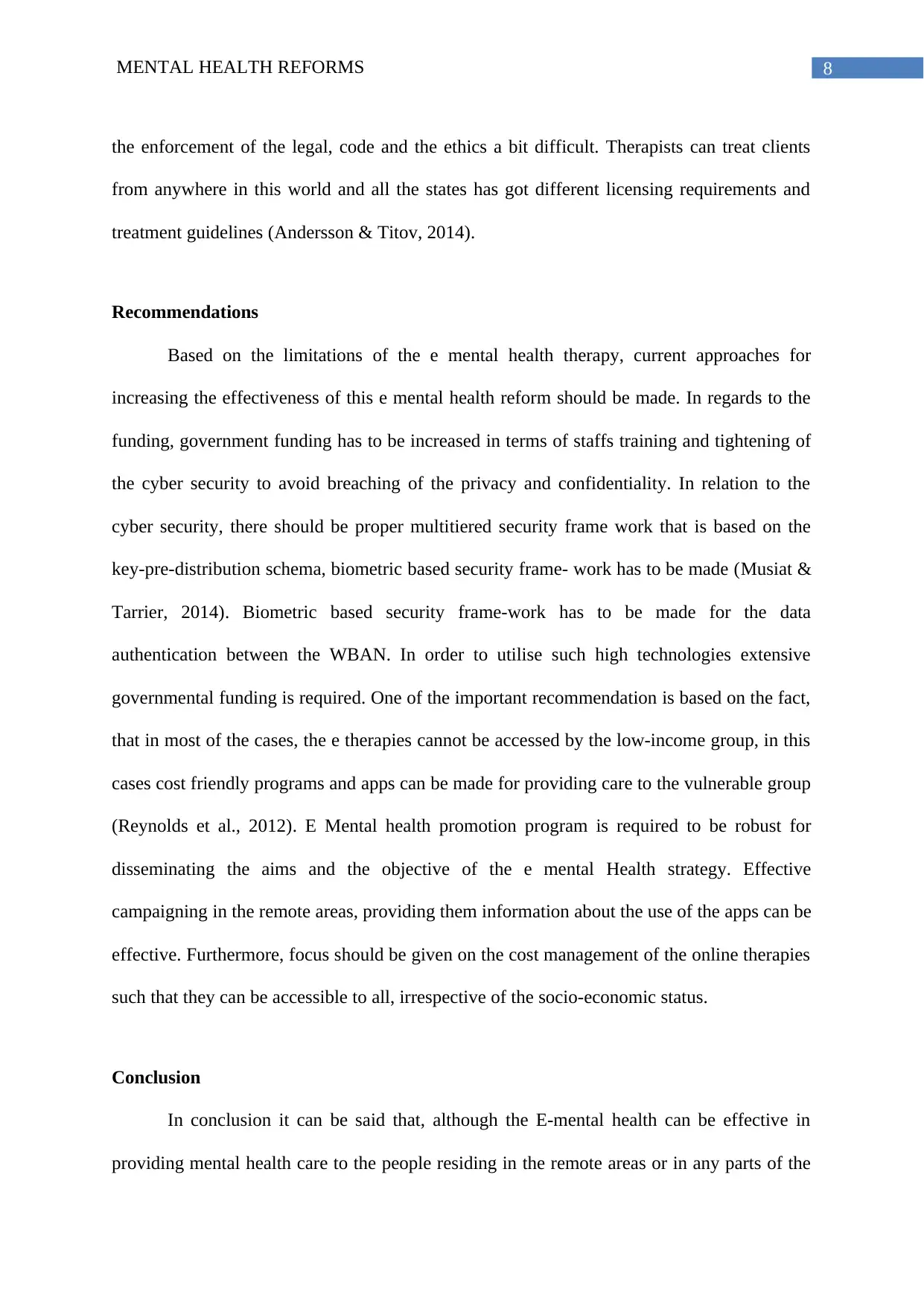
8MENTAL HEALTH REFORMS
the enforcement of the legal, code and the ethics a bit difficult. Therapists can treat clients
from anywhere in this world and all the states has got different licensing requirements and
treatment guidelines (Andersson & Titov, 2014).
Recommendations
Based on the limitations of the e mental health therapy, current approaches for
increasing the effectiveness of this e mental health reform should be made. In regards to the
funding, government funding has to be increased in terms of staffs training and tightening of
the cyber security to avoid breaching of the privacy and confidentiality. In relation to the
cyber security, there should be proper multitiered security frame work that is based on the
key-pre-distribution schema, biometric based security frame- work has to be made (Musiat &
Tarrier, 2014). Biometric based security frame-work has to be made for the data
authentication between the WBAN. In order to utilise such high technologies extensive
governmental funding is required. One of the important recommendation is based on the fact,
that in most of the cases, the e therapies cannot be accessed by the low-income group, in this
cases cost friendly programs and apps can be made for providing care to the vulnerable group
(Reynolds et al., 2012). E Mental health promotion program is required to be robust for
disseminating the aims and the objective of the e mental Health strategy. Effective
campaigning in the remote areas, providing them information about the use of the apps can be
effective. Furthermore, focus should be given on the cost management of the online therapies
such that they can be accessible to all, irrespective of the socio-economic status.
Conclusion
In conclusion it can be said that, although the E-mental health can be effective in
providing mental health care to the people residing in the remote areas or in any parts of the
the enforcement of the legal, code and the ethics a bit difficult. Therapists can treat clients
from anywhere in this world and all the states has got different licensing requirements and
treatment guidelines (Andersson & Titov, 2014).
Recommendations
Based on the limitations of the e mental health therapy, current approaches for
increasing the effectiveness of this e mental health reform should be made. In regards to the
funding, government funding has to be increased in terms of staffs training and tightening of
the cyber security to avoid breaching of the privacy and confidentiality. In relation to the
cyber security, there should be proper multitiered security frame work that is based on the
key-pre-distribution schema, biometric based security frame- work has to be made (Musiat &
Tarrier, 2014). Biometric based security frame-work has to be made for the data
authentication between the WBAN. In order to utilise such high technologies extensive
governmental funding is required. One of the important recommendation is based on the fact,
that in most of the cases, the e therapies cannot be accessed by the low-income group, in this
cases cost friendly programs and apps can be made for providing care to the vulnerable group
(Reynolds et al., 2012). E Mental health promotion program is required to be robust for
disseminating the aims and the objective of the e mental Health strategy. Effective
campaigning in the remote areas, providing them information about the use of the apps can be
effective. Furthermore, focus should be given on the cost management of the online therapies
such that they can be accessible to all, irrespective of the socio-economic status.
Conclusion
In conclusion it can be said that, although the E-mental health can be effective in
providing mental health care to the people residing in the remote areas or in any parts of the
⊘ This is a preview!⊘
Do you want full access?
Subscribe today to unlock all pages.

Trusted by 1+ million students worldwide
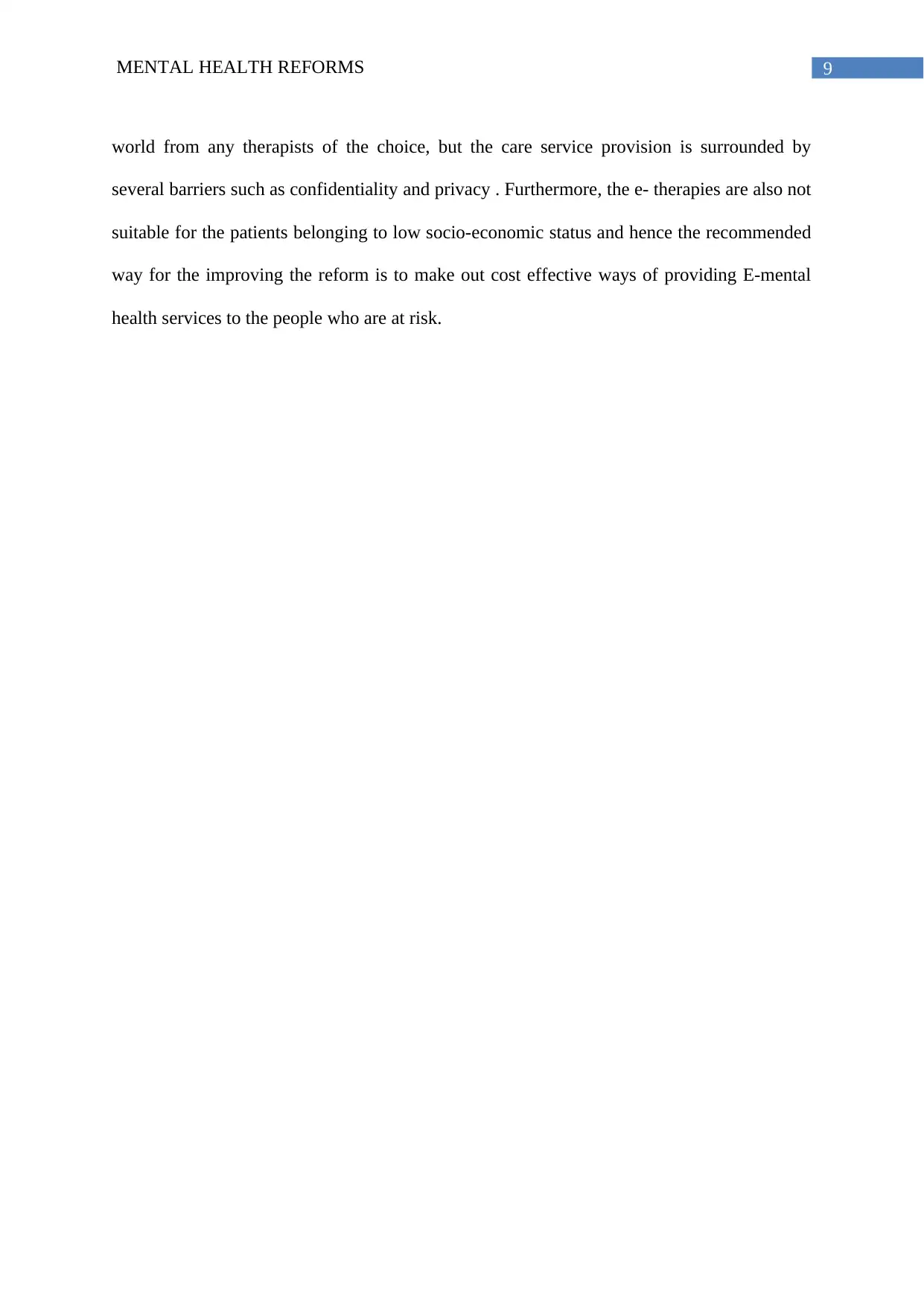
9MENTAL HEALTH REFORMS
world from any therapists of the choice, but the care service provision is surrounded by
several barriers such as confidentiality and privacy . Furthermore, the e- therapies are also not
suitable for the patients belonging to low socio-economic status and hence the recommended
way for the improving the reform is to make out cost effective ways of providing E-mental
health services to the people who are at risk.
world from any therapists of the choice, but the care service provision is surrounded by
several barriers such as confidentiality and privacy . Furthermore, the e- therapies are also not
suitable for the patients belonging to low socio-economic status and hence the recommended
way for the improving the reform is to make out cost effective ways of providing E-mental
health services to the people who are at risk.
Paraphrase This Document
Need a fresh take? Get an instant paraphrase of this document with our AI Paraphraser
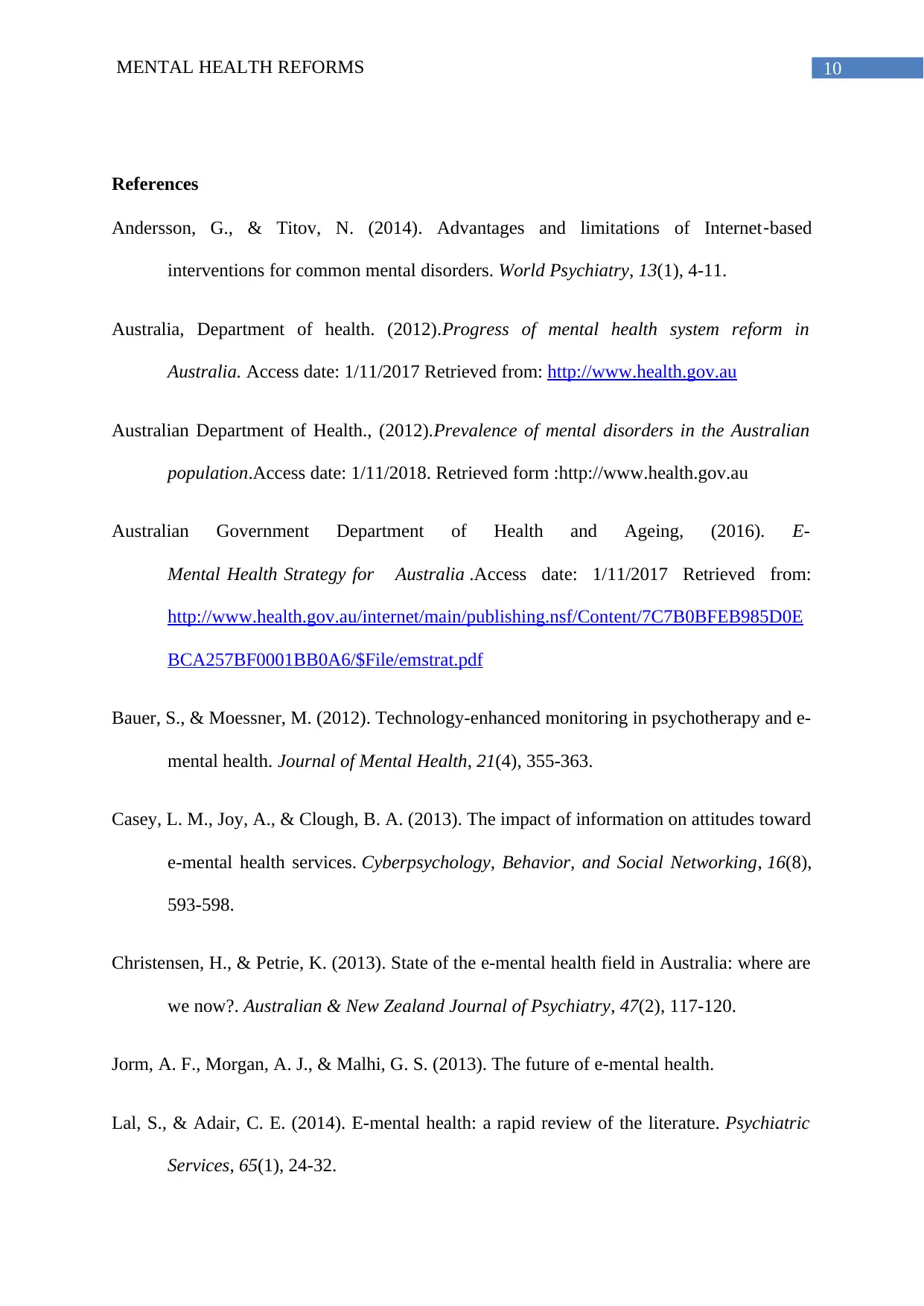
10MENTAL HEALTH REFORMS
References
Andersson, G., & Titov, N. (2014). Advantages and limitations of Internet‐based
interventions for common mental disorders. World Psychiatry, 13(1), 4-11.
Australia, Department of health. (2012).Progress of mental health system reform in
Australia. Access date: 1/11/2017 Retrieved from: http://www.health.gov.au
Australian Department of Health., (2012).Prevalence of mental disorders in the Australian
population.Access date: 1/11/2018. Retrieved form :http://www.health.gov.au
Australian Government Department of Health and Ageing, (2016). E‐
Mental Health Strategy for Australia .Access date: 1/11/2017 Retrieved from:
http://www.health.gov.au/internet/main/publishing.nsf/Content/7C7B0BFEB985D0E
BCA257BF0001BB0A6/$File/emstrat.pdf
Bauer, S., & Moessner, M. (2012). Technology-enhanced monitoring in psychotherapy and e-
mental health. Journal of Mental Health, 21(4), 355-363.
Casey, L. M., Joy, A., & Clough, B. A. (2013). The impact of information on attitudes toward
e-mental health services. Cyberpsychology, Behavior, and Social Networking, 16(8),
593-598.
Christensen, H., & Petrie, K. (2013). State of the e-mental health field in Australia: where are
we now?. Australian & New Zealand Journal of Psychiatry, 47(2), 117-120.
Jorm, A. F., Morgan, A. J., & Malhi, G. S. (2013). The future of e-mental health.
Lal, S., & Adair, C. E. (2014). E-mental health: a rapid review of the literature. Psychiatric
Services, 65(1), 24-32.
References
Andersson, G., & Titov, N. (2014). Advantages and limitations of Internet‐based
interventions for common mental disorders. World Psychiatry, 13(1), 4-11.
Australia, Department of health. (2012).Progress of mental health system reform in
Australia. Access date: 1/11/2017 Retrieved from: http://www.health.gov.au
Australian Department of Health., (2012).Prevalence of mental disorders in the Australian
population.Access date: 1/11/2018. Retrieved form :http://www.health.gov.au
Australian Government Department of Health and Ageing, (2016). E‐
Mental Health Strategy for Australia .Access date: 1/11/2017 Retrieved from:
http://www.health.gov.au/internet/main/publishing.nsf/Content/7C7B0BFEB985D0E
BCA257BF0001BB0A6/$File/emstrat.pdf
Bauer, S., & Moessner, M. (2012). Technology-enhanced monitoring in psychotherapy and e-
mental health. Journal of Mental Health, 21(4), 355-363.
Casey, L. M., Joy, A., & Clough, B. A. (2013). The impact of information on attitudes toward
e-mental health services. Cyberpsychology, Behavior, and Social Networking, 16(8),
593-598.
Christensen, H., & Petrie, K. (2013). State of the e-mental health field in Australia: where are
we now?. Australian & New Zealand Journal of Psychiatry, 47(2), 117-120.
Jorm, A. F., Morgan, A. J., & Malhi, G. S. (2013). The future of e-mental health.
Lal, S., & Adair, C. E. (2014). E-mental health: a rapid review of the literature. Psychiatric
Services, 65(1), 24-32.
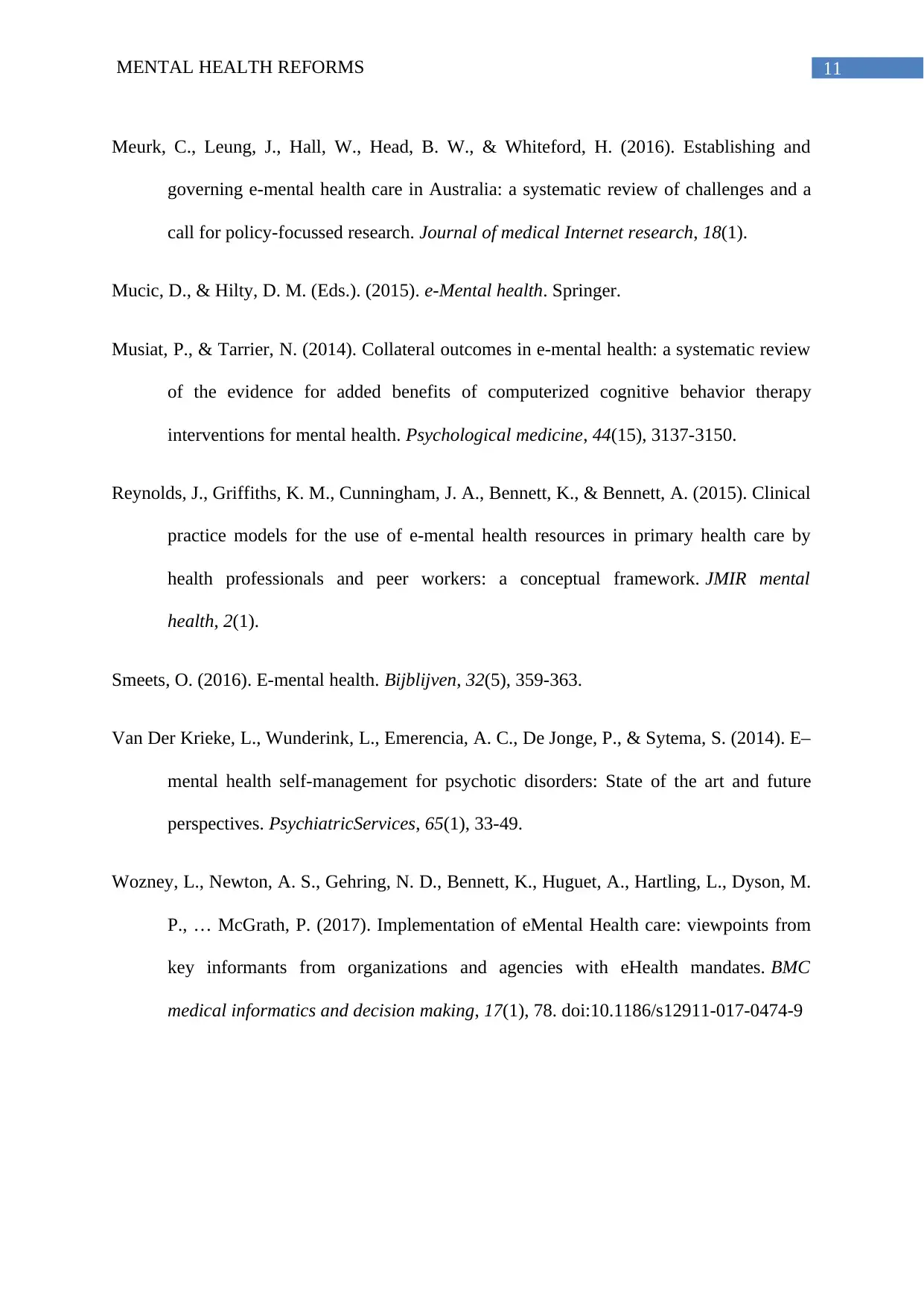
11MENTAL HEALTH REFORMS
Meurk, C., Leung, J., Hall, W., Head, B. W., & Whiteford, H. (2016). Establishing and
governing e-mental health care in Australia: a systematic review of challenges and a
call for policy-focussed research. Journal of medical Internet research, 18(1).
Mucic, D., & Hilty, D. M. (Eds.). (2015). e-Mental health. Springer.
Musiat, P., & Tarrier, N. (2014). Collateral outcomes in e-mental health: a systematic review
of the evidence for added benefits of computerized cognitive behavior therapy
interventions for mental health. Psychological medicine, 44(15), 3137-3150.
Reynolds, J., Griffiths, K. M., Cunningham, J. A., Bennett, K., & Bennett, A. (2015). Clinical
practice models for the use of e-mental health resources in primary health care by
health professionals and peer workers: a conceptual framework. JMIR mental
health, 2(1).
Smeets, O. (2016). E-mental health. Bijblijven, 32(5), 359-363.
Van Der Krieke, L., Wunderink, L., Emerencia, A. C., De Jonge, P., & Sytema, S. (2014). E–
mental health self-management for psychotic disorders: State of the art and future
perspectives. PsychiatricServices, 65(1), 33-49.
Wozney, L., Newton, A. S., Gehring, N. D., Bennett, K., Huguet, A., Hartling, L., Dyson, M.
P., … McGrath, P. (2017). Implementation of eMental Health care: viewpoints from
key informants from organizations and agencies with eHealth mandates. BMC
medical informatics and decision making, 17(1), 78. doi:10.1186/s12911-017-0474-9
Meurk, C., Leung, J., Hall, W., Head, B. W., & Whiteford, H. (2016). Establishing and
governing e-mental health care in Australia: a systematic review of challenges and a
call for policy-focussed research. Journal of medical Internet research, 18(1).
Mucic, D., & Hilty, D. M. (Eds.). (2015). e-Mental health. Springer.
Musiat, P., & Tarrier, N. (2014). Collateral outcomes in e-mental health: a systematic review
of the evidence for added benefits of computerized cognitive behavior therapy
interventions for mental health. Psychological medicine, 44(15), 3137-3150.
Reynolds, J., Griffiths, K. M., Cunningham, J. A., Bennett, K., & Bennett, A. (2015). Clinical
practice models for the use of e-mental health resources in primary health care by
health professionals and peer workers: a conceptual framework. JMIR mental
health, 2(1).
Smeets, O. (2016). E-mental health. Bijblijven, 32(5), 359-363.
Van Der Krieke, L., Wunderink, L., Emerencia, A. C., De Jonge, P., & Sytema, S. (2014). E–
mental health self-management for psychotic disorders: State of the art and future
perspectives. PsychiatricServices, 65(1), 33-49.
Wozney, L., Newton, A. S., Gehring, N. D., Bennett, K., Huguet, A., Hartling, L., Dyson, M.
P., … McGrath, P. (2017). Implementation of eMental Health care: viewpoints from
key informants from organizations and agencies with eHealth mandates. BMC
medical informatics and decision making, 17(1), 78. doi:10.1186/s12911-017-0474-9
⊘ This is a preview!⊘
Do you want full access?
Subscribe today to unlock all pages.

Trusted by 1+ million students worldwide
1 out of 12
Related Documents
Your All-in-One AI-Powered Toolkit for Academic Success.
+13062052269
info@desklib.com
Available 24*7 on WhatsApp / Email
![[object Object]](/_next/static/media/star-bottom.7253800d.svg)
Unlock your academic potential
Copyright © 2020–2025 A2Z Services. All Rights Reserved. Developed and managed by ZUCOL.





